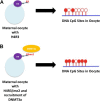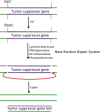The Evolution of Epigenetics: From Prokaryotes to Humans and Its Biological Consequences
- PMID: 27512339
- PMCID: PMC4973776
- DOI: 10.4137/GEG.S31863
The Evolution of Epigenetics: From Prokaryotes to Humans and Its Biological Consequences
Abstract
The evolution process includes genetic alterations that started with prokaryotes and now continues in humans. A distinct difference between prokaryotic chromosomes and eukaryotic chromosomes involves histones. As evolution progressed, genetic alterations accumulated and a mechanism for gene selection developed. It was as if nature was experimenting to optimally utilize the gene pool without changing individual gene sequences. This mechanism is called epigenetics, as it is above the genome. Curiously, the mechanism of epigenetic regulation in prokaryotes is strikingly different from that in eukaryotes, mainly higher eukaryotes, like mammals. In fact, epigenetics plays a significant role in the conserved process of embryogenesis and human development. Malfunction of epigenetic regulation results in many types of undesirable effects, including cardiovascular disease, metabolic disorders, autoimmune diseases, and cancer. This review provides a comparative analysis and new insights into these aspects.
Keywords: diseases; epigenetics; eukaryotes; evolution; mammals; prokaryotes.
Figures




References
Publication types
LinkOut - more resources
Full Text Sources
Other Literature Sources
Research Materials

